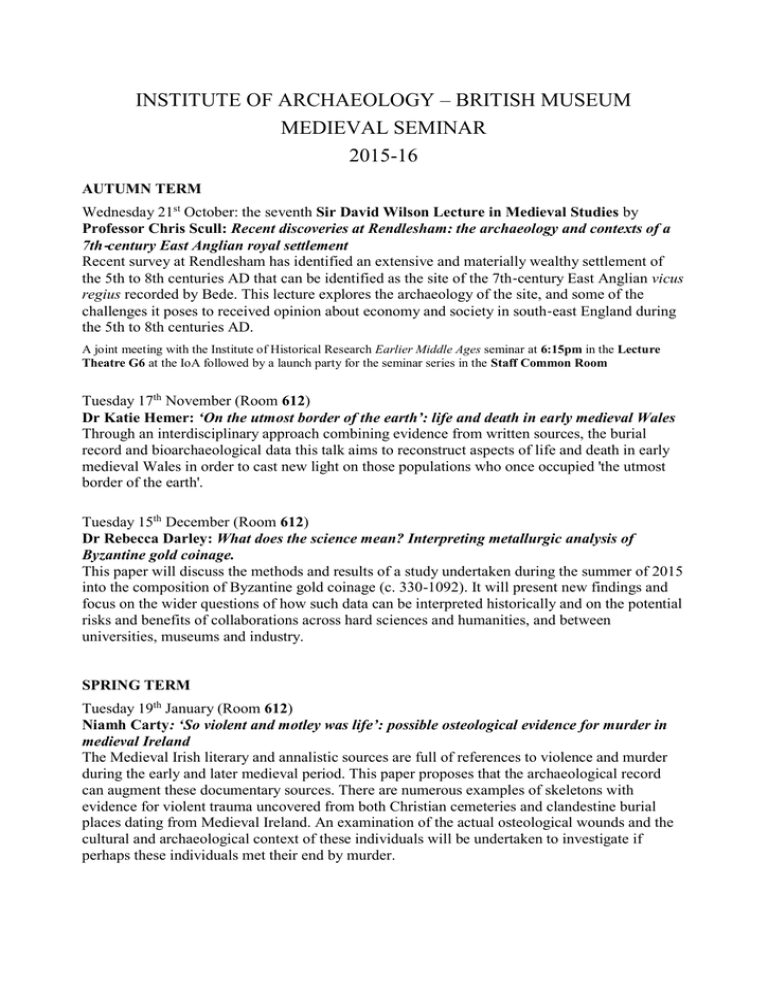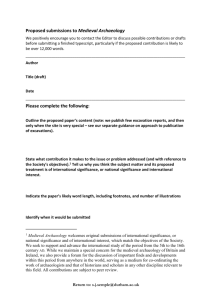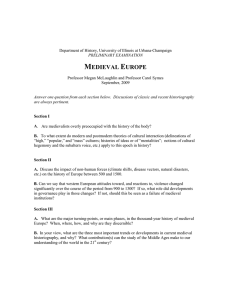INSTITUTE OF ARCHAEOLOGY – BRITISH MUSEUM MEDIEVAL SEMINAR 2015-16
advertisement

INSTITUTE OF ARCHAEOLOGY – BRITISH MUSEUM MEDIEVAL SEMINAR 2015-16 AUTUMN TERM Wednesday 21st October: the seventh Sir David Wilson Lecture in Medieval Studies by Professor Chris Scull: Recent discoveries at Rendlesham: the archaeology and contexts of a 7th‐century East Anglian royal settlement Recent survey at Rendlesham has identified an extensive and materially wealthy settlement of the 5th to 8th centuries AD that can be identified as the site of the 7th‐century East Anglian vicus regius recorded by Bede. This lecture explores the archaeology of the site, and some of the challenges it poses to received opinion about economy and society in south‐east England during the 5th to 8th centuries AD. A joint meeting with the Institute of Historical Research Earlier Middle Ages seminar at 6:15pm in the Lecture Theatre G6 at the IoA followed by a launch party for the seminar series in the Staff Common Room Tuesday 17th November (Room 612) Dr Katie Hemer: ‘On the utmost border of the earth’: life and death in early medieval Wales Through an interdisciplinary approach combining evidence from written sources, the burial record and bioarchaeological data this talk aims to reconstruct aspects of life and death in early medieval Wales in order to cast new light on those populations who once occupied 'the utmost border of the earth'. Tuesday 15th December (Room 612) Dr Rebecca Darley: What does the science mean? Interpreting metallurgic analysis of Byzantine gold coinage. This paper will discuss the methods and results of a study undertaken during the summer of 2015 into the composition of Byzantine gold coinage (c. 330-1092). It will present new findings and focus on the wider questions of how such data can be interpreted historically and on the potential risks and benefits of collaborations across hard sciences and humanities, and between universities, museums and industry. SPRING TERM Tuesday 19th January (Room 612) Niamh Carty: ‘So violent and motley was life’: possible osteological evidence for murder in medieval Ireland The Medieval Irish literary and annalistic sources are full of references to violence and murder during the early and later medieval period. This paper proposes that the archaeological record can augment these documentary sources. There are numerous examples of skeletons with evidence for violent trauma uncovered from both Christian cemeteries and clandestine burial places dating from Medieval Ireland. An examination of the actual osteological wounds and the cultural and archaeological context of these individuals will be undertaken to investigate if perhaps these individuals met their end by murder. Tuesday 16th February (Room 612) Maria Duggan: Britain in the early medieval Atlantic: the ceramic evidence for international connections Pottery of Mediterranean origin has been identified at sites in southwestern Britain since the publication of finds from Tintagel in the 1950s. These imports have typically been used to demonstrate some sort of direct connection between western Britain and the Byzantine World in the fifth and sixth century. New discoveries in Britain have increased the scale and diversity of this material, while recently published finds from Ireland, France, Spain and Portugal have suggested a more complex picture of distribution. This talk will discuss recent research to assess the presence of this pottery on the Western Seaboard, which has revealed new understandings of contact and exchange in the early medieval Atlantic. Tuesday 15th March (Room 612) Vicky Manolopoulou: Movement and prayer: the litanies in Byzantine Constantinople In medieval minds Constantinople was the queen of cities, a world-famous jewel under the protection of God and His mother the Theotokos. The city's sacred landscape hosted the relics of saints and was perceived as a church. The city was the location of religious processions, the echoes of which can be found in various primary sources such as the Typicon of the Great Church. These processions are recorded as having salvific and protective properties acting as a link between people and the divine. This paper examines the spatiotemporal dimension of religious movement in order to understand its role in creating a sacred landscape. It adopts an inter-disciplinary approach towards the archaeology of religion and practice in the Byzantine capital and suggests that sacred landscapes are not static amalgams but exist and are transformed through experience SUMMER TERM Wednesday 11th May (Room 612) Dr Corisande Fenwick: Building God’s empire: archaeology, religion and the Byzantine reconquest of Africa In 533-4, after nearly a hundred years of Vandal rule, the Emperor Justinian conquered Africa and made it Roman once more. Justinian’s self-proclaimed aim went beyond restoring Roman rule in the West to the far-reaching ambition of uniting a doctrinally divided Christian world under one Empire, one God and one Church. Much recent scholarship explores the new relationships between church and state that emerged in this period through the lens of religious texts and Christian iconography but the most substantial body of evidence– the archaeological remains of hundreds of churches that were built or restored in Africa after the Byzantine conquest – has been overlooked. This paper accordingly combines analysis of regional patterns of church-building with topographic analysis of how churches ‘worked’ in towns to provide a new material-based account of religion, politics and imperialism in sixth-century North Africa. Followed by a summer party in the Staff Common Room ALL MEETINGS START AT 6pm AT THE INSTITUTE OF ARCHAEOLOGY with the exception of the Wilson Lecture on Wednesday 21 October which is in G6 and starts at 6.15 pm Convenors Sue Brunning (BM) sbrunning@britishmuseum.org Andrew Reynolds (IoA) a.reynolds@ucl.ac.uk Meetings Secretary: Rhiannon Comeau (IoA) rhiannon.comeau.10@ucl.ac.uk Sponsored by the World Archaeology Section (IoA) and the British Museum






